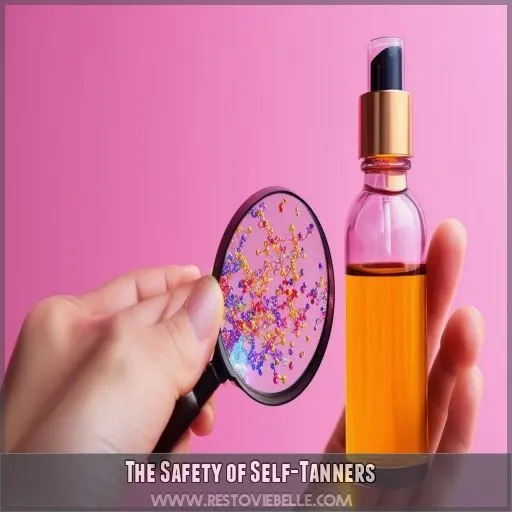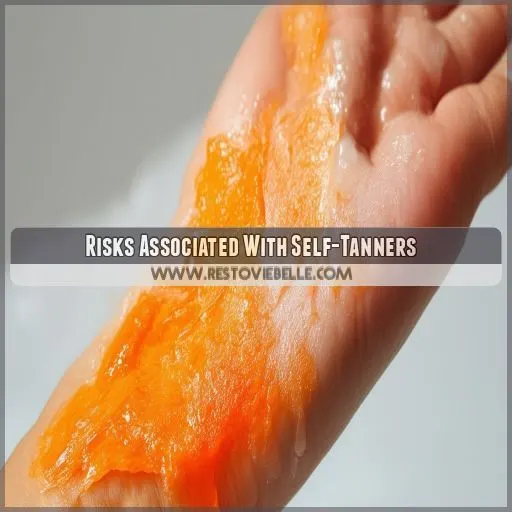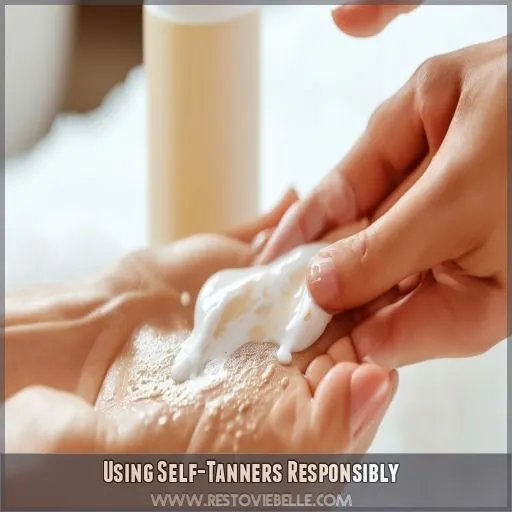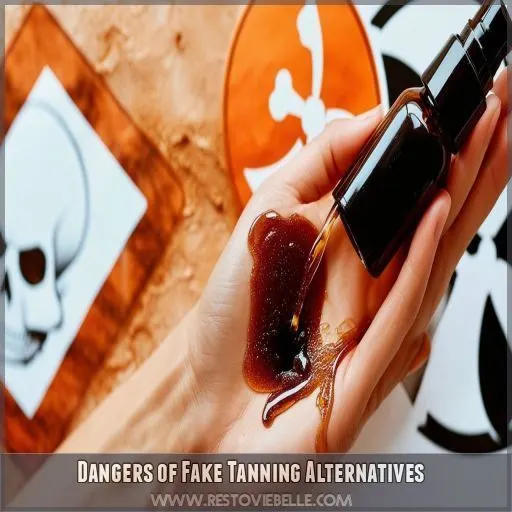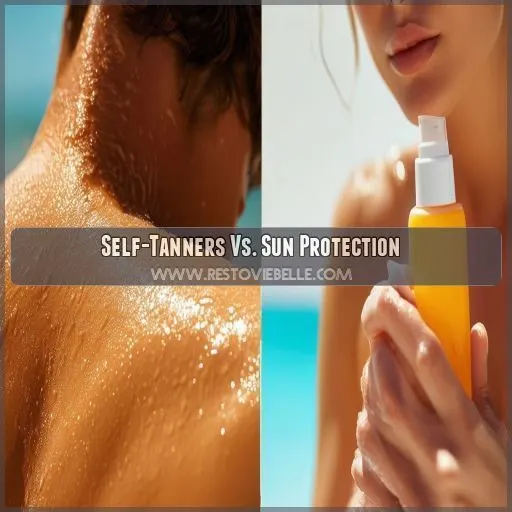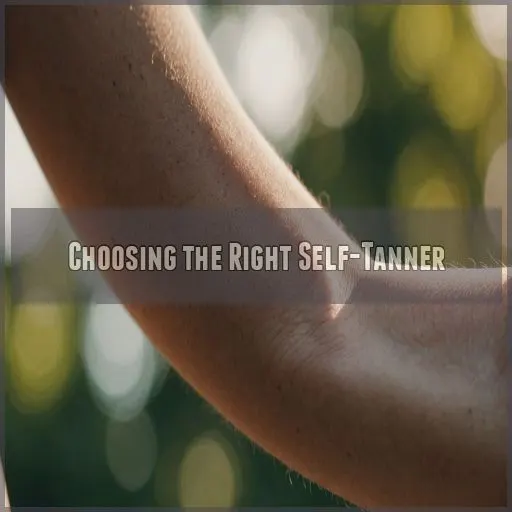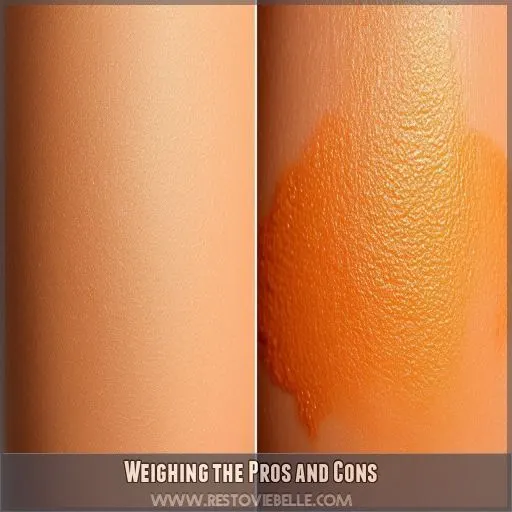This site is supported by our readers. We may earn a commission, at no cost to you, if you purchase through links.
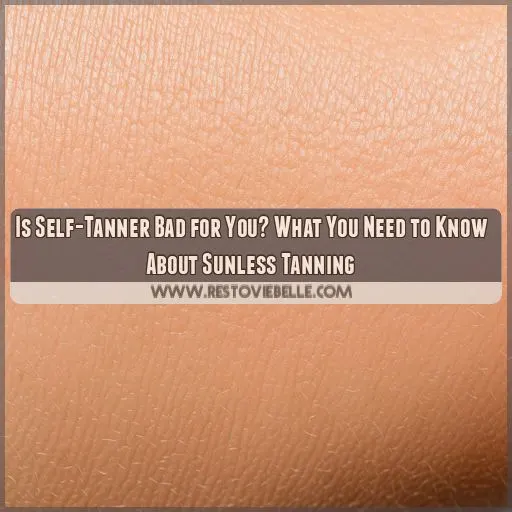
You’ll want to steer clear of certain chemicals and know how to use self-tanners responsibly.
Table Of Contents
- Key Takeaways
- The Safety of Self-Tanners
- Risks Associated With Self-Tanners
- Using Self-Tanners Responsibly
- Dangers of Fake Tanning Alternatives
- Self-Tanners Vs. Sun Protection
- Choosing the Right Self-Tanner
- Weighing the Pros and Cons
- Frequently Asked Questions (FAQs)
- Does fake tan cause health problems?
- Is self-tanner bad for your skin long term?
- Does fake tan age your skin?
- What are the cons of self-tanner?
- How long does a self-tan last?
- Is self-tanner safe for sensitive skin?
- Can you get a spray tan if youre pregnant?
- Does self-tanner work on all skin tones?
- Can you use self-tanner on your face?
- Conclusion
Key Takeaways
- Self-tanners are safer than sunbathing or tanning beds, but they’re not risk-free. The chemicals in self-tanners can increase free radicals, potentially leading to premature skin aging.
- Inhaling self-tanner spray can be harmful, potentially causing cell damage and triggering lung issues like asthma.
- Allergic reactions and skin irritation are possible, so always do a patch test before fully applying any self-tanner product.
- While self-tanners give you a sun-kissed glow, they offer minimal SPF protection. Always use sunscreen with SPF 15 or higher to protect your skin from UV damage.
The Safety of Self-Tanners
You might be wondering if self-tanners are safe to use. After all, we’ve all heard the horror stories of orange palms and streaky legs. But are there any hidden dangers lurking beneath that golden glow? Let’s take a closer look at the safety profile of self-tanners and uncover any potential risks.
How Self-Tanners Work
Self-tanners are lotions, sprays, and gels that give you a sun-kissed look without the sun’s help. They work by using a chemical reaction, similar to how food browns when cooked. The key ingredient, DHA, reacts with your skin’s surface to create a tan that lasts a few days.
The Maillard Reaction
Ever wondered why food turns brown when you cook it? It’s because of something called the Maillard reaction—a chemical reaction that also happens to be the secret behind self-tanners.
This reaction is all about browning. In self-tanners, it’s what gives you that sun-kissed look without the sun. It’s a clever bit of food science applied to skin chemistry.
But how does it work? Well, it’s all about the ingredients and their concentration.
DHA and Erythrulose
Now, let’s get a little technical and talk about the ingredients that make self-tanners tick. The main active ingredient in self-tanners is called dihydroxyacetone, or DHA for short. This sugar reacts with the top layer of your skin, staining it a darker color to create that sun-kissed look. It’s like giving your skin a temporary tan without any UV exposure.
Some self-tanning formulas also include erythrulose, which is similar to DHA and helps enhance the color. These two ingredients are the dynamic duo responsible for that bronzed glow.
Melanoidins and the Tanned Look
The Maillard reaction is what gives self-tanners their magic.
This chemical reaction, similar to how food browns when cooked, causes DHA and erythrulose to react with your skin proteins, creating melanoidins.
These melanoidins are the key to achieving that coveted tanned look.
They develop and darken over a few hours, giving you a natural-looking tan without the sun.
It’s like a little science experiment on your skin, but a safe and controlled one!
Risks Associated With Self-Tanners
While self-tanners can give you a sun-kissed glow without the sun’s harmful rays, they’re not entirely risk-free. In this section, we’ll explore the potential downsides of self-tanners, from skin aging to allergic reactions, so you can make an informed decision about whether to use them.
Free Radicals and Skin Aging
Self-tanners can give you a sun-kissed glow without the sun’s harmful rays, but there are some things to keep in mind, especially with free radicals and skin aging. Here’s what you need to know:
- Free Radicals and Collagen Damage: Self-tanners contain an ingredient called dihydroxyacetone (DHA), which can increase free radicals in your skin. These free radicals can damage collagen and elastin, leading to premature skin aging. Think of free radicals as mischievous molecules that cause chaos in your skin cells, resulting in fine lines and wrinkles.
- Oxidative Stress and UV Exposure: Preliminary research suggests that UV exposure on freshly tanned skin can further increase free radical production. This means that sunbathing or hitting the beach right after applying self-tanner mightn’t be the best idea.
- Antioxidant Benefits: To combat the effects of free radicals, look for self-tanner formulations that include antioxidants. Antioxidants are like your skin’s superhero squad, fighting off the damage caused by free radicals and helping to protect your skin.
Inhalation Risks and Cell Damage
Self-tanner isn’t just about your skin. Inhaling self-tanner spray can be risky, potentially causing cell damage and triggering lung conditions like asthma with repeated exposure.
| Lung Health Risks | Potential Impact |
|---|---|
| Inhalation | Cell damage, triggering asthma |
| Lung Conditions | COPD, other lung issues |
The risks don’t end there. Inhaling certain ingredients in self-tanner could also lead to oxidative damage, impacting the DNA of your cells. So, it’s not just about avoiding that orange-tinted look; it’s about keeping your lungs and cells happy and healthy.
Allergic Reactions and Skin Irritation
Allergic reactions and skin irritation are potential risks when using self-tanners. While these products are generally safe, some individuals may experience sensitivity to certain ingredients. Here’s what you need to watch out for:
- Allergic Reactions: Self-tanners contain active ingredients like dihydroxyacetone (DHA) and, in some cases, erythrulose. These can trigger allergic reactions in rare cases, causing skin irritation or even more severe reactions.
- Patch Test: Always perform a patch test before fully applying self-tanner. Choose a small area of your skin, preferably somewhere discreet, and apply a small amount of the product. Wait 24 hours to see if any adverse reactions occur.
- Safe Products: Opt for self-tanners with simple, natural ingredient lists to minimize the risk of irritation. Avoid products with added fragrances or unnecessary additives, as these can be common irritants.
UV Exposure and Free Radical Production
There’s some evidence that UV exposure on freshly tanned skin can increase free radical production, leading to potential skin damage.
So, while self-tanners may give you a sun-kissed look, they don’t offer much protection against UV rays.
To stay safe, always apply sunscreen with an SPF of 15 or higher after using self-tanner, and reapply it every two hours when you’re out in the sun.
Using Self-Tanners Responsibly
So, you’re thinking of getting that sun-kissed glow without the sun’s rays? Self-tanners can give you that bronzed look, but there’s an art to using them right.
Here, you’ll discover how to use self-tanners responsibly, from mastering the art of contouring to avoiding those tell-tale stains.
Guide Color and Contouring
Self-tanner with a guide color is a game-changer for contouring. This feature helps you see where you’ve applied it, ensuring even application and preventing streaks or tan lines. It’s like a practice run, so you don’t end up with an uneven skin appearance.
Practice Before Events and Removing Stains
Self-tanner is all about practice. You don’t want to end up with a streaky or uneven tan, especially before a big event. Here’s the deal:
- Practice makes perfect: Don’t try contouring with self-tanner for the first time before a special occasion. It takes a bit of trial and error to master the technique and avoid mistakes.
- DIY self-tanner: If you’re new to self-tanning, start with a gradual self-tanner or a product that builds colour over time. This gives you more control and reduces the risk of ending up with an overly dark tan.
- Aftercare products: Avoid salt water and chlorinated pools for at least a few hours after applying self-tanner. These can affect the colour and cause streaking.
- Tanning injections and pills: Steer clear of unregulated tanning injections and pills. These products can be dangerous and cause serious side effects. Stick to topical self-tanners that have been approved for use.
Prevention and Stain Removal Techniques
Self-tanner stains can be a pain to deal with, but there are ways to prevent and tackle them.
To avoid stains on your clothes or sheets, opt for dark colours after applying self-tanner.
Make sure to shower before your skin comes into contact with light-coloured fabrics to reduce the risk of staining.
If you do end up with a stain, blot it from the outside in to remove it effectively.
Dangers of Fake Tanning Alternatives
While self-tanners offer a safer alternative to sunbathing or tanning beds, let’s explore the dangers of other fake tanning methods. From tanning beds to tanning pills, we’ll uncover the risks you should know about before opting for a quick tan.
Tanning Beds and Sunlamps
Tanning beds and sunlamps may give you a bronzed glow, but they come with some serious risks:
- They expose you to high levels of ultraviolet (UV) rays, which can damage your skin and increase your risk of skin cancer, including melanoma.
- These UV rays can also cause cataracts and eye cancers, so it’s not just your skin that’s at risk.
- You might be tempted to use them as a "quick fix," but they can lead to premature aging and immune suppression.
- The statistics are scary: Over 400,000 skin cancer cases in the U.S. each year are linked to indoor tanning, and that’s not a risk worth taking.
Skin Cancers and Premature Aging
Tanning beds and sunlamps are linked to some scary health risks. Over 400,000 skin cancer cases in the U.S. each year are estimated to be related to indoor tanning. That’s not a risk worth taking. These artificial rays can also cause cataracts, eye cancers, and immune suppression.
The UV rays from tanning beds accelerate the aging of your skin, causing wrinkles and age spots. It’s a double whammy of damage that leaves you with an increased risk of skin cancer and looking older than your years.
Fake Tanning Lotions and Melanotan II
Let’s talk about fake tanning lotions and the infamous Melanotan II, aka the "Barbie Drug."
Fake tanning lotions often contain DHA, which is approved for topical use in the U.S. and seems safer than sunbathing or tanning beds. However, for folks with an altered skin barrier, DHA can cause some oxidative damage. But for most people with normal skin, it’s unlikely to cause any serious issues.
On the other hand, Melanotan II is a whole different story. This unregulated, unapproved drug isn’t something you want to mess with. It alters the immune regulation of pigmented cells, causing moles to change and potentially leading to melanoma. Skin cancer is the biggest risk, but Melanotan II also comes with a laundry list of side effects, from painful erections to kidney problems and everything in between.
Tanning Pills and Unapproved Ingredients
Tanning pills are a hard no-go zone. Many contain canthaxanthin, a pigment that can mess with your liver and eyes, and some even cause fatal blood disorders. You’re better off steering clear of these sketchy pills and opting for FDA-approved sunless tanning lotions.
Self-Tanners Vs. Sun Protection
While self-tanners give you a sun-kissed glow, they don’t offer much protection against UV rays. In fact, most self-tanners have an SPF of 3 to 4, which is way lower than the recommended SPF of 30 or higher.
So, if you’re planning to soak up some sun, don’t rely on your self-tanner alone. Always remember to slather on that sunscreen to protect your skin from sun damage and lower your risk of skin cancer and premature aging.
SPF Ratings and UV Protection
You might be tempted to skip sunscreen when using self-tanner, but don’t fall for that trap! Most self-tanners offer minimal SPF protection, so even with a golden glow, you need to shield your skin from those rays. Always pair self-tanner with sunscreen to protect against UV damage.
Sunscreen Recommendations and Timing
Even though self-tanners might offer a bit of sun protection, it’s not enough to rely on. Here’s what you should do to stay safe:
- Apply sunscreen: Make sure to apply sunscreen with an SPF of 15 or higher after your self-tanner has dried.
- Reapply often: Don’t forget to reapply sunscreen every two hours, especially if you’re swimming or sweating.
- Avoid excessive sun exposure: Even with sunscreen, it’s best to limit your time in the sun, especially during peak hours.
- Look for antioxidants: Choose self-tanner formulas with antioxidants and sunscreen ingredients to boost protection.
The Importance of Sun Protection
While self-tanners can give you a sun-kissed glow, they don’t offer much protection against the sun’s rays. In fact, most self-tanners only have an SPF of 3 to 4, which is like wearing no sunscreen at all!
| Protection Method | SPF Rating | Safety |
|---|---|---|
| Self-Tanner | 3-4 | Minimal |
| Sunscreen | 15+ | Recommended |
| Sun Avoidance | N/A | Crucial |
As you can see, self-tanners just don’t cut it when it comes to sun protection. You wouldn’t walk out into the sun wearing SPF 4 sunscreen, would you? So, don’t rely on self-tanners for sun protection either.
The sun’s UV rays are no joke. They can cause sunburns, premature aging, and even skin cancer. So, it’s important to practice safe sun habits. Always use sunscreen with an SPF of 15 or higher, and reapply it often, especially after swimming or sweating. And remember, even if you’re using self-tanner, avoid prolonged sun exposure. Your skin will thank you!
Choosing the Right Self-Tanner
So, you’re thinking about getting a tan, but there are so many ways to do it! Bronzers, tanning salons, FDA-approved lotions and creams, even airbrush tans – it can be overwhelming.
In this section, we’ll break down the pros and cons of each option so you can pick the method that fits your style and comfort level.
Bronzers and Tanning Salons
Bronzers are like magic wands that give you a temporary tan. They’re makeup products that safely impart color to your skin, but it washes off or wears off after a few hours. Some even come with SPF 15, giving you a little sun protection.
As for tanning salons, it’s best to give them a hard pass. Those UVA rays are just as damaging as UVB rays, and you don’t want to risk sunburn, skin cancer, or premature aging.
FDA-approved Sunless Tanning Lotions and Creams
When choosing a self-tanner, opt for lotions or creams with DHA as the active ingredient. These are generally considered safe and effective for achieving a sunless tan.
Here are some key considerations when selecting an FDA-approved sunless tanning lotion or cream:
- Safety First: Always prioritize products with a strong safety profile. Avoid tanning pills, which often contain unapproved ingredients, and be cautious of sprays, which can be inhaled.
- Skin Sensitivities: If you have sensitive skin, opt for fragrance-free options to minimize the risk of irritation or allergic reactions.
- Gradual Build: Look for formulas that build gradually over time, reducing the risk of an uneven tan or streaking.
- Moisturizing Benefits: Many modern self-tanners include moisturizing ingredients, providing an added bonus of hydrating your skin while achieving a sun-kissed glow.
Airbrush Tans or Tanning Sprays
If you’re considering a spray tan salon, you might be wondering about the safety of tanning sprays. Spray tans can give you a natural-looking summer glow without the risks of UV exposure. But are they completely safe?
Tanning sprays can be a great option if you’re careful during application. The biggest risk is inhaling the product, which could trigger asthma or lead to other lung issues. Always hold your breath, wear a mask, and keep your eyes and mouth closed during application. Avoid getting the spray too close to your face.
Weighing the Pros and Cons
Now that you know the risks and benefits of self-tanning, it’s time to weigh the pros and cons. Should you embrace the sun-kissed glow or steer clear? Let’s help you decide.
The Benefits of Self-Tanners
There are several perks to using self-tanners. Here are some reasons why you might choose to go the self-tanning route:
- Year-round glow: You can get a sun-kissed look without the sun. No more waiting for summer to get that golden glow!
- Convenience: Self-tanners are a DIY option you can use at home, saving time and money on salon visits or outdoor tanning.
- Variety: With different shades and formulas, you can find your perfect match. Whether you want a subtle hint of color or a deep tan, there’s a self-tanner for you.
The Drawbacks of Self-Tanners
Self-tanners may have some drawbacks that are good to be aware of. While self-tanners are generally safe, some potential cons include:
| Drawback | |
|---|---|
| Skin Aging | DHA can increase free radicals, potentially damaging collagen and elastin, and contributing to skin aging. |
| Inhalation Risks | Inhaling the spray can cause cell damage and trigger conditions like asthma with repeated exposure. |
| Allergic Reactions | Some individuals may experience allergic reactions or skin irritation. |
| UV Exposure | There’s evidence that UV exposure on freshly tanned skin can increase free radical production, so sunscreen is a must. |
| Staining | The "guide color" in self-tanners can stain light-colored fabrics, so be cautious. |
Comparing Self-Tanners to Natural Tans
So, is self-tanner better than a natural tan? Well, it depends. If you’re impatient like me and want a tan pronto, self-tanner’s your guy. But if you’re a beach bum who lives for that tropical glow, a natural tan might be more your jam.
Self-tanners give you control over your tan’s shade and intensity, and you can rock a tan year-round, even in winter. But natural tans from sun exposure can be a hassle to maintain, especially if you live in a gloomy, rainy area.
On the flip side, natural tans can be a free, easy option if you’re lucky enough to live in a sunny spot. But self-tanners require more effort and can get pricey, especially if you’re maintaining a full-body tan.
Making an Informed Decision
Now that you’ve weighed the pros and cons, it’s time to make a decision.
If you’re keen on a sun-kissed glow, self-tanners offer a safer alternative to sun exposure or tanning beds. They’re generally safe, but it’s important to be cautious and informed about potential risks.
Frequently Asked Questions (FAQs)
Does fake tan cause health problems?
Fake tan products containing DHA were deemed safe by experts in However, some people experience negative reactions, including elevated liver enzymes, nausea, abdominal pain, and extreme fatigue.
Is self-tanner bad for your skin long term?
Self-tanner is generally safe, but there are some concerns about long-term use. DHA, the active ingredient, can increase free radicals in the skin, potentially contributing to skin aging. Inhalation of spray tans is also a concern, as it can cause cell damage and trigger asthma.
Does fake tan age your skin?
The jury’s still out on whether fake tan ages your skin. Dermatologists say it could cause wrinkles and sagging, but others disagree, saying it’s safer than sun exposure.
What are the cons of self-tanner?
Self-tanner: the ultimate fake-it-till-you-make-it product.
But let’s be real, are there any downsides to this sun-kissed-skin-in-a-bottle?
Well, besides the potential for streaky application and orange palms, there are a few things to think about.
First, the active ingredient DHA can increase free radicals, potentially causing skin ageing.
Inhaling the spray can irritate lungs, and there’s always the risk of an allergic reaction.
How long does a self-tan last?
Your self-tan can last anywhere from 4 to 6 days, depending on your skin type, the self-tanner, and how you care for your skin. Oily skin can make it last 5 to 6 days, while dry skin may only last 1 to 2 days.
Is self-tanner safe for sensitive skin?
Yes, but proceed with caution. Some self-tanners are designed for sensitive skin, but always patch test first. Avoid products with fragrances and preservatives, which can irritate sensitive skin.
Can you get a spray tan if youre pregnant?
It’s best to consult your doctor or healthcare provider. While some sources say it’s fine, others recommend avoiding it due to potential inhalation risks.
Does self-tanner work on all skin tones?
Sure, self-tanner can work on all skin tones, but you need to pick the right one. Some formulas are designed for lighter skin tones, while others are meant for deeper complexions.
Can you use self-tanner on your face?
Yes, you can use self-tanner on your face, but it’s best to choose a product specifically designed for facial skin, as body self-tanners may cause irritation and clogged pores. Look for formulas with 100% natural DHA that are hydrating and noncomedogenic.
Conclusion
So, is self-tanner bad for you?
Well, it’s a mixed bag. While self-tanners are safer than sun exposure,
the chemicals in them can increase free radicals, leading to potential skin ageing.
To avoid risks, use self-tanners responsibly, steering clear of specific chemicals.
Avoid alternatives like tanning beds and pills, which are linked to skin cancer and unapproved ingredients.
Choose FDA-approved sunless tanners, and always protect your skin with sunscreen.
Weigh the pros and cons, and maybe embrace your natural tan – it’s a safer bet!

